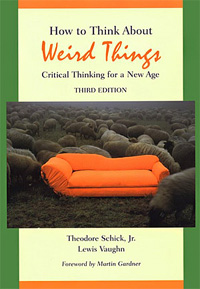This book was required reading for the following courses: (1) “Science, Skepticism & Weird Behavior” taught by Bryan Lovelace, (2) “Skepticism & the Scientific Worldview” taught by Travis Knowles, (3) “Skepticism, Science & the Paranormal” taught by Martin Brigdstock, and (4) “The Scientific Method: Critical & Creative Thinking” taught by Stephen Sekula et al.
This brief text helps students to think critically, using examples from the weird claims and beliefs that abound in our culture to demonstrate the sound evaluation of any claim. It explains step-by-step how to sort through reasons, evaluate evidence, and tell when a claim (no matter how strange) is likely to be true. The emphasis is neither on debunking nor on advocating specific assertions, but on explaining principles of critical thinking that enable readers to evaluate claims for themselves. The authors focus on types of logical arguments and proofs, making How to Think about Weird Things a versatile supplement for logic, critical thinking, philosophy of science, or any other science appreciation courses.
James Randi calls this textbook, “the most powerful, comprehensive, and readable collections of examples, explanations and caveats that I could have ever hoped for.” A library must!
Resource type: book recommendations
Academic discipline: parapsychology • philosophy • psychology
Academic level: college and university









